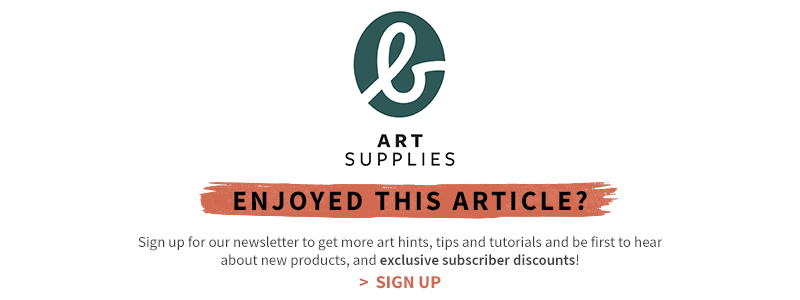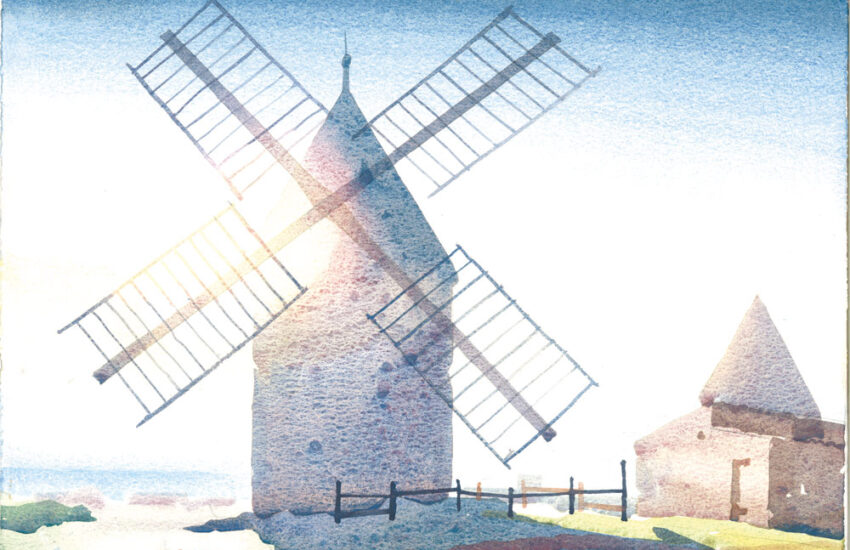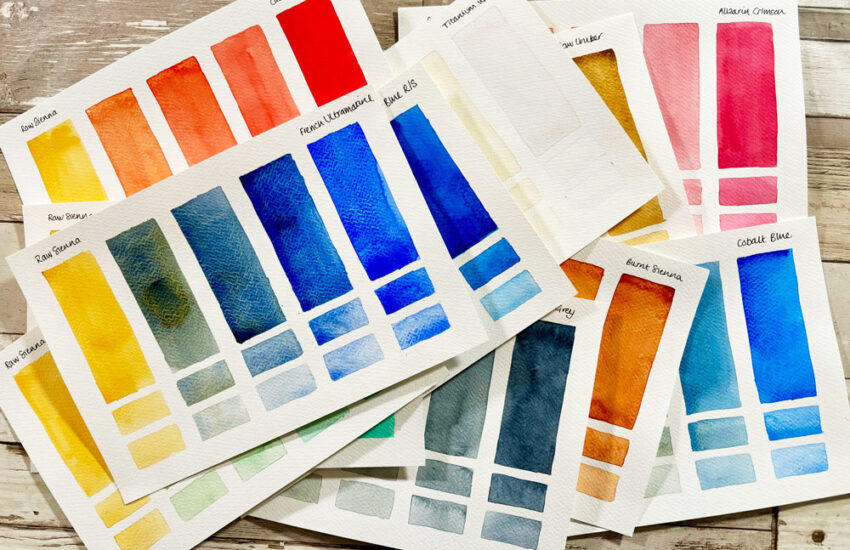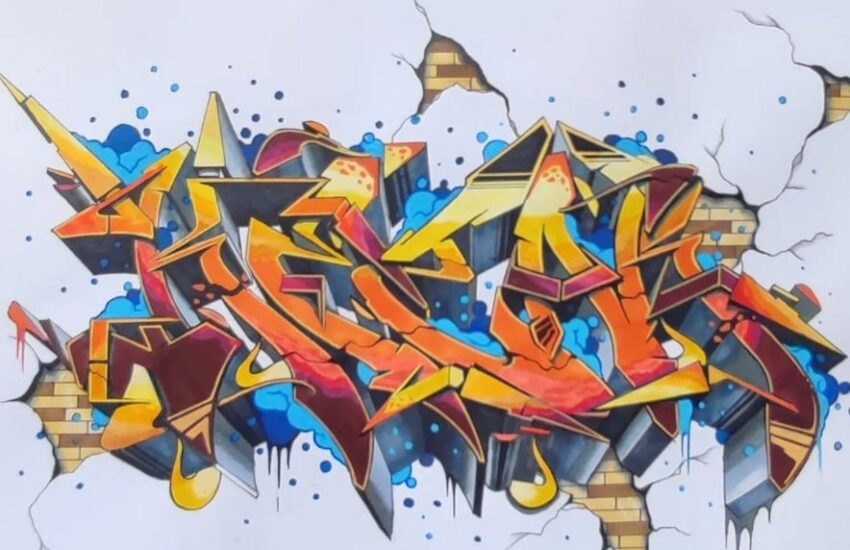A Beginners Guide to Choosing the Right Watercolour Brush
If you’re new to Watercolour Painting the amount of Watercolour Brushes can seem a little overwhelming. You’ve chosen your paints and paper, and are eager to paint – but how do you choose which brushes to go for? In this blog post we take a look at the types of brushes on offer – covering shapes, hair types and more – to help you find the brush that’s perfect for you.

Visit our Watercolour Brushes product range and you’ll find a vast array of artists paint brushes in all kinds of shapes and sizes. Of course each shape and range of brushes has its specific purpose, but if you’re going in without much knowledge of brushes it can be difficult to know exactly what you’re looking at or what you’re looking for. In this blog post we’ll look at all the characteristics of different watercolour brush hairs and shapes. And give you an idea of the properties you’ll need to consider before you pick out a selection of brushes to purchase.
Understanding Brush Anatomy
Before we look at some of the specific qualities of watercolour brushes, it’s a good start to get yourself familiar with some brush anatomy and terminology. If you’re on the search for a new brush, you may have already come across terms like ferrule, crimp and belly. But what exactly do these terms mean? You an split the basic anatomy of a brush into the head, the ferrule and the handle. Take a look at the diagram below and we’ll look at these parts in more detail.

Brush Head
The Brush Head is the part of your brush where the hair is. The hair of your brush can consist of natural hair, synthetic fibers, or a blend of both.
Tip
When we talk about the tip we’re refering to the very end of the brush – where the point of a round brush would be – to differentiate from the ‘belly’ of the brush.
Belly
The ‘belly’ is the slightly bulbous part of a brush head, above the ferrule, where the brush is at its thickest . It’s a term you might see mentioned in the description of round and quill brushes. The belly of the brush acts like a reservoir and holds the paint or ink you’re working with. The larger the belly, the more colour the brush will hold.
Heel
The heel of a brush is where the hairs of the brush head meet the ferrule.
Ferrule
The ferrule is the metal cuff that fits between the brush hairs and the handle to hold them together. Most ferrules are made from nickel plated brass that is resistant to corrosion and splitting. The ferrule on Quill and Mop brushes is slightly different. The handle end of the ferrule will be crimped to hold it in place. Rather than a metal ferrule they sometimes have a plastic cuff bound to the brush with wires.
Handle
The handle of a watercolour brush is typically made from painted and lacquered wood. On the handle you’re likely to find all kinds of information that will help you identify your brush. This can include the size, manufacturer’s name, series number and shape name. There may also be information about the country of manufacture. Most watercolour brushes are short handled to enable close up work, but there are exceptions.
What properties should I look for in a watercolour brush?

Colour Capacity & Load – Watercolour painting is synonymous with big, bold washes. So perhaps the most important quality of a watercolour brush will be its ability to hold large amounts of water. Not only should your brush hold a good amount of colour, it should also offer a consistent flow of colour from the brush tip. There’s nothing worse than having to reload your brush constantly. Or finding that your strokes skip because the colour isn’t flowing as it should.

Snap and spring – These are two important properties as they determine the types of techniques you can use the brush with. Both properties relate to how well the brush holds its original shape. Good snap will mean that the brush bounces back to its original shape, while spring determines how well the brush holds its shape during painting. Different brushes offer different amounts of snap and spring. For example, squirrel hair brushes will feel quite soft and floppy compared to a stiffer synthetic brush.

Fine Point – There’s a high probability that you’ll have at least one or two pointed round brushes in your artistic toolkit. And if you’re working in fine detail, it’s essential that a round brush holds it’s point well. A brush with a fine point gives you more control over your strokes. This is particularly useful when you’re working on delicate areas or when you need to paint fine lines with accuracy.
Which is best a natural or synthetic watercolour brush?
It was once widely thought that natural hair was the very best choice for watercolour painting. Artists have always sought after Kolinsky Sable in particular. However, synthetic technology improved in leaps and bounds since the first introduction of synthetic brushes. Not only has this widened the choice of brushes considerably, some contemporary synthetics present natural hair brushes with some stiff competition.
Natural Hair
Animal hair naturally suits watercolour painting due to its organic structure. There are thousands of tiny, interlocking scales on the surface of each hair. In nature, this structure increases the surface area of the hair and helps keep the animal warm.

In watercolour brushes, this structure works to our advantage as it attracts and holds onto liquid. This increased absorbency not only gives the brush better colour holding capacity but also provides greater control in colour application.

Sable

Watercolour Artists hold Sable in very high regard. This hair is sourced from a species of weasel commonly found in Siberia and Manchuria. It can vary in colour quite dramatically from a light, golden brown to a rich red. The very finest sable brushes are made exclusively from the winter coat of the male weasel. Lower grade sables will use a hair blend from both female and male pelts. Before being made into a brush, Sable hair is graded and sorted. You’ll see some variation in the types of sable available.
Kolinsky
Kolinsky is the finest hair for brush making sourced from ‘Mustela Sibirica’. Brushes using exclusively the winter coat of the male animal are considered to be the best quality sable brushes. Cheaper Kolinsky brushes will use a blend of male and female hair.
Tobolsky-Kolinsky
Sable hair sourced from ‘Mustela Sibirica’ populations in the basins of the Ob, Lena, Amur and Tobol rivers. The male animals have an extraordinarily bushy tail that is prized for brush making. Found in Da Vinci Maestro brushes.
Red Sable
Red Sable are lesser quality hairs from the ‘Mustela Sibirica’. Typically a little stiffer and have less spring. The hairs wear down quicker than the finest grade hair.
Sable/Brown Sable
Any brushes sold simply as sable or brown sable brushes will most likely be made from lower grade hairs. The quality of this hair varies greatly.
The natural shape of sable hair lends itself well to creating a brush with a large belly. Each fibre is thicker at the bottom and tapers to a fine point. You’ll also see sable brushes being marketed as ‘taper-dressed’. This means that the hair is sorted by length before being shaped into the brush tip. Various lengths of hair will be used to make a single brush, with the longest hairs in the centre. This, along with the natural shape of the hair creates a brush tip with an exceptionally large belly and a sharp, precision point.
It’s the fine point of Sable that has earned it its status among watercolourists, along with its spring. The spring of the hair, as well as its length and fineness will all affect the price of the brush. The Siberian Weasel doesn’t breed well in captivity. This, along with its isolated population, makes the hair especially difficult to harvest and also contributes to their high price tag.
Squirrel

You’ll typically find squirrel hair in quill and mop brushes as it’s ideal for holding the high amounts of colour you need for large washes. Squirrel hair is dense and soft, offering far less spring than sable. In fact, squirrel hair brushes can feel quite floppy, so much so that some artists find them a little unruly. A dry squirrel brush can look a little bushy and untamed, but give it a dip in some water and you’ll find that the fibres form a point. The point isn’t as sharp as sable, so won’t be the best for precision work. Squirrel brushes work best when they’re thoroughly wet, so they might benefit from a quick soaking before use to get rid of any trapped air between the hairs.
You might come across some variation in the naming of squirrel brushes. Kazan Squirrel is sourced from the Kazan region of Russia. This type of squirrel hair is considered to be the very best quality, offering unparalleled softness and a controlled flow of colour. Blue Squirrel doesn’t have quite the same softness as Kazan, but still performs well in a mop brush.
Goat

Goat hair is an inexpensive natural fibre that is widely available. Unlike sable and squirrel, it isn’t common in our brush ranges, but you will find it in some Mop and Hake brushes. It’s a durable hair that is relatively soft, although coarser than both sable and squirrel.
Pony

Pony hair is a low cost natural hair you might come across in economical school-grade brushes and Chinese painting and calligraphy brushes. It’s a reasonably soft hair that holds enough colour for wash techniques, but does not hold a point for fine detail work.
Synthetic Hair

Nylon and Polyester are two common materials you’ll find in Synthetic brushes. These man-made fibres don’t have the same natural scales and flags as natural hair. When they were first introduced, this meant that a synthetic brush couldn’t hold anywhere near the amount of colour a natural hair brush would. However, advancements in synthetic technology now mean that synthetics are able to more closely mimic the qualities of natural hair.
Some brush makers make high end synthetics that mimic the natural properties of particular types of natural hair. In fact, some ranges are almost impossible to distinguish from their natural counterparts.
Synthetic Sable Brushes
Princeton Aqua Elite
Escoda Versatil
Pro Arte Sablene
Panart Synthetic Sable
Da Vinci Colineo
W&N Synthetic Sable
Synthetic Squirrel Brushes
Panart Synthetic Squirrel
Escoda Ultimo
Da Vinci Casaneo
W&N Synthetic Squirrel
Synthetics that aren’t marketed as alternatives to natural hair may be a little bit stiffer and hold less paint, but don’t count them out! The smoothness of the hair and the fine points can be great for fine detail painting.
One benefit of synthetics over natural hair is that they are much more forgiving of abuse. They can withstand an amazing amount of use, especially if you’re painting daily. Clean and care for your synthetic brush properly and they’ll have a considerably long lifespan. Another benefit is their affordability. Compare a natural and synthetic brush of the same size and the synthetic will be a much more budget-friendly price.
Natural and Synthetic Blends

Synthetic Natural Mix brushes use a blend of both natural and synthetic fibres to create a brush that offers the benefits of both fibres. Depending on the type of natural hair used, the sable or squirrel hair will bring an excellent colour holding capacity to the brush. While the synthetics impart enhanced durability. Another benefit of these brushes is that if you’re comparing sizes across ranges, they are typically much cheaper than a pure sable brush in the same size.
Which Brush Size Do I Need?
As a rule, the larger the number on your brush the bigger the brush will be. We measure most brush shapes in numbers ranging from 000 to around about 24, but some ranges may go slightly larger or smaller than this. Extra small brushes, like a 000, may sometimes be labelled as a 3/0. A 0000 would be 4/0 and so on. Flat brushes sometimes use the same numbering system, but can also have their size denoted in inch or millimetre measurements. Unfortunately, brush makers don’t share the same sizing systems, so a size 6 in one brand won’t be the same as a size 6 from another brand. Don’t worry, we include accurate sizing information across all our brush ranges, so you’ll know exactly the size of the brush you’re ordering.
If you’re working on a small to medium scale and looking to buy a single brush to begin with we’d recommend a mid-sized round, probably around a size 6 or 8. If you’re after a few rounds to try then adding in a smaller brush for fine detail (around a size 1 or 2) and a larger brush (size 10 or 12) will broaden the size of strokes you can make. A 1/2” Flat can also add a bit more versatility if you want to branch out beyond rounds. A set can often be an economical way to try out a few different brushes from one range.
Understanding the Difference Between Brush Shapes
Round

A round brush will likely be the workhorse of your brush collection. They’re probably the brush you’ll reach for most as they can create an amazingly varied array of marks. They’re typically available in a range of fibres, whether natural or synthetic. The hair of a round brush sits in a cylindrical ferrule and tapers to a point at the end. The pointed tip of a round is fantastic for creating fine lines. Apply more pressure to the brush and you can paint bolder marks. A round brush with a more blunt end is fantastic for filling in areas with colour.
Pointed Round

A pointed round is much the same as a standard round brush, however the hair tends to extend a little further out of the ferrule. They combine the best of a round brush and a liner. The longer hair allows you to make larger strokes while also retaining the ability to create fine lines. The extra hair also comes with an increased colour holding capacity.
Miniature

A Miniature brush is a very small round brush ideal for fine detail painting. The hair doesn’t extend very far out of the ferrule and for the smallest sizes can appear to be only a few fibres thick. While these brushes don’t hold a tremendous amount of colour, their precision tip affords you the control to apply even the most minute details.
Rigger

Rigger brushes have a similar profile to round brushes but the hair is considerably longer. Their name derives from their original purpose – painting the rigging on maritime paintings. The length of the hair not only means the brush can hold higher volumes of water but it also reduces any wobbles caused by your hand shaking. You can also rest your brush holding hand against your painting surface while being able to see the trajectory of your stroke clearly.
Flat

A Flat Brush is made from hair fibres arranged with a sharp square edge in a flat ferrule. They’re great for laying colour down quickly, especially in larger sizes. There are also different profiles of the brush to use. The large flat face might be great for bold strokes but the thin edge is brilliant for creating more delicate lines. The squared edge of the tip also adds a sharp geometric end to your strokes. You may see flat brushes marketed as One Stroke brushes by some brands.
Angled

An Angled brush has a similar profile to a flat brush. The brush fibres are held in a flat ferrule, but instead of being arranged in a straight square shaped tip they are slightly angled. This slanted shape makes these brushes ideal for blending in hard to reach areas. Plus, their tip creates crisp edges, fine lines and allows you to work with precision. They’re also great for painting leaves, petals and grasses in a single stroke.
Dagger/Sword

Dagger brushes, sometimes referred to as dagger stripers or sword liners, have an unusual shape. They look almost like a hybrid of a filbert and an angled brush. The shorter edge of the brush usually has a delicate curve similar to that of a filbert, whereas the longer edge angles to a fine point. They can range from being quite short and stubby to long and flexible.
Wash

Flat Wash brushes look very similar to a standard flat brush in that they have hairs arranged across a ferrule to form a straight edge. They tend to be a lot larger than a standard flat brush and typically have flat handles – similar to the type of brush you’d use for DIY.

Oval Wash and Cat’s Tongue – These are both large brushes with a curved profile. An oval wash looks similar to a large filbert. You might hear a pointed oval wash brush referred to as a cat’s tongue. This type of oval wash brush has the same filbert-like curve but tapers to a point.
Filbert

Filberts combine the best of a flat and a round brush. They have hairs arranged in a flat profile along the ferrule, but rather than having a squared edge at the tip the gently round off to a curve. This curved tip means they make much softer brush marks than a flat brush, so they’re suitable for blending. The shape also lends itself well to painting petals. You can use a filbert on its side to create fine lines, or use the flat side to block in areas of colour. By twisting the brush as you paint you can create decorative flourishes.
Quill

A Quill brush looks like a large round brush but with a much larger belly. This type of brush offers a brilliant combination of colour holding capacity and a fine point. The belly of the brush acts as a large reservoir for holding colour while the finely tapered point allows you to paint in fine detail. These brushes are brilliant if you’re looking to paint a large area quickly as you won’t need to reload your brush as frequently. Quill brushes take their name from the binding that holds the brush together. Rather than the usual metal ferrule these brushes have a plastic cuff that holds together the brush fibres and the handle. There are usually a series of wires circling the cuff. Originally this cuff was made from the quill of a bird’s feather.
Mop

Mop brushes are large, brushy brushes that hold exceptional amounts of water. Unlike a quill brush that tapers to a point, mop brushes have a rounded tip. The volume of hair in the brush tip means that these brushes can hold large quantities of colour, so they’re great for covering large areas quickly.
Fan

As the name suggests a fan brush is made from a series of fibres fanned out across a flat ferrule. These brushes aren’t typically very thick and you’ll notice that the hair thins out towards the end. This shape is useful for blending, but you can also use them for special effects. Using them with a dry brush technique can yield some interesting patterns and textures that are useful for capturing grasses, fur and other natural textures.
Hake

The Hake is a traditional goat hair brush used for Japanese sumi-e ink painting. Much like a flat they feature hair arranged in a flat formation with a straight edge. Unlike a standard flat brush, Hake brushes have natural wooden handles and don’t use a traditional ferrule, instead the hair is glued and tied to the handle. They also have a large flat handle. They’re useful for painting with a loose watercolour technique or creative large washes.
Special Effects
In addition to our range of standard watercolour brushes, we also stock a range of brushes that are great for painting special effects. These types of brushes are available in a range of unusual shapes and sizes and are brilliant for artists looking to work with more specialist techniques. There are brushes similar to mops that are suitable for blending, comb-like brushes that are useful for painting grasses and furs and more!
Why is my New Watercolour Brush Hard and Crusty?
We ship most if not all of our Watercolour Brushes to you with a gum arabic solution holding the bristles in place. Not only does this offer a bit of added protection during shipping, but if you’re handling the brush in person before purchasing it gives you a good idea of what the tip will look like when its wet. Before using the brush to paint with, you’ll need to remove the gum coating by rinsing the brush under warm water. Gently work the gum out of the tip, playing particular attention to the area close to the ferrule. Any residue close to the ferrule can mean the brush won’t shape properly.

Once you’ve rinsed out the gum and the brush has dried, don’t be alarmed if the tip looks a little splayed or bushy. Once you dip the brush in water it should return to its shape.
How do I Choose the Best Watercolour Brush?

Ultimately, choosing a brush will come down to a mix of personal preference and the style of painting that you do. Sometimes it isn’t a question of finding the ‘best’ brush – more discovering the brush that’s right for you. You might spend a small fortune on the finest sables, only to discover that a more economical synthetic suits the job better. Before purchasing a brush, think about the types of painting’s you’ll be making. What technique will you be painting with? Are you working with loose, expressive strokes or more precision detail? Are you ok using animal hair? Consider these questions as you look through our watercolour brush range and you should be able to find the perfect brush for the job.









Hi Bromleys & Tanith. I live in New Zealand in a wheelchair. I am just beginning with Watercolour and really appreciated this blog about brushes. I will use this guidence as I choose my tools and travel down the Watercolour trail. Thanks heeeeps. 😀
Hi Garth, hello from England! You are welcome, I’m glad you found the guide helpful. Good luck with your new hobby!
Great extremely informative. Thank you.